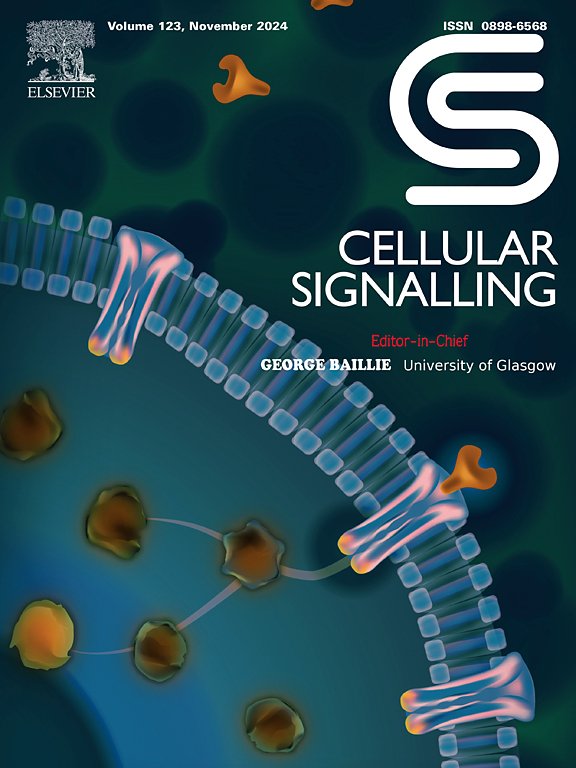STAT5/VCAN/PI3K信号通路促进成纤维细胞活化和肺纤维化
IF 3.7
2区 生物学
Q2 CELL BIOLOGY
引用次数: 0
摘要
肺纤维化(PF)是一种进行性和衰弱性疾病,其特征是细胞外基质(ECM)成分过度沉积。成纤维细胞的激活和大量ECM的产生是PF发生的重要因素,本研究旨在阐明VCAN (versican, VCAN)促进PF发生的作用和机制,并寻找治疗PF的靶点。方法采用气管灌注博来霉素或射线致纤维化方法建立小鼠肺纤维化模型,评价VCAN的表达水平。采用组织免疫荧光法和小鼠原代细胞提取法确定VCAN的细胞定位。利用VCAN基因敲除小鼠成纤维细胞,我们通过免疫组织化学和免疫荧光分析了VCAN对肺纤维化程度和成纤维细胞活化的影响。提取小鼠原代成纤维细胞,利用人/小鼠源性成纤维细胞系,通过免疫荧光、Transwell、scratch和western blotting检测VCAN/PI3K通路对成纤维细胞活化的影响及其特异性机制。利用蛋白印迹、染色质免疫沉淀、荧光素酶报告基因分析和实时定量聚合酶链反应研究STAT5/VCAN信号。此外,用vcan特异性敲低病毒或PI3K抑制剂治疗的小鼠体内评估了PF的发病机制。结果VCAN在PF小鼠成纤维细胞中的表达显著升高,特异性敲除成纤维细胞中的VCAN后,PF小鼠肺成纤维细胞的活化水平和肺纤维化水平均显著降低。在机制上,STAT5作为转录因子在博莱霉素诱导下促进VCAN的表达。高VCAN表达通过PI3K途径促进成纤维细胞活化,使用特异性敲低腺相关病毒或PI3K抑制剂抑制VCAN可显著减轻PF小鼠的肺纤维化。结论stat5是一个增强VCAN表达的转录因子;VCAN通过PI3K信号通路响应转录因子STAT5,促进成纤维细胞活化,从而促进肺纤维化。STAT5/VCAN/PI3K信号通路可能作为肺纤维化治疗的潜在靶点。本文章由计算机程序翻译,如有差异,请以英文原文为准。

STAT5/VCAN/PI3K signaling pathway promotes fibroblast activation and lung fibrosis
Rationale
Pulmonary fibrosis (PF) is a progressive and debilitating disease characterized by the excessive deposition of extracellular matrix (ECM) components. The activation of fibroblasts and the production of large amounts of ECM are important factors in the development of PF. This study aimed to elucidate the role and mechanism of versican (VCAN) in promoting PF and to identify therapeutic targets for PF.
Methods
A mouse lung fibrosis model was constructed by tracheal instillation of bleomycin or ray-induced fibrosis in mice, and the expression level of VCAN was evaluated. The cellular localization of VCAN was determined using tissue immunofluorescence and the extraction of primary mouse cells. Using mice with specific VCAN knockout in fibroblasts, we analyzed the effects of VCAN on the degree of lung fibrosis and fibroblast activation via immunohistochemistry and immunofluorescence. Primary mouse fibroblasts were extracted, and human/mouse-derived fibroblast cell lines were used to assess the effect of the VCAN/PI3K pathway on fibroblast activation and its specific mechanism through immunofluorescence, Transwell, scratch, and western blotting assays. STAT5/VCAN signaling was investigated using protein blotting, chromatin immunoprecipitation, luciferase reporter gene analysis, and real-time quantitative polymerase chain reaction. Further, the pathogenesis of PF was evaluated in vivo in mice treated with a VCAN-specific knockdown virus or PI3K inhibitors.
Results
VCAN expression was significantly elevated in the fibroblasts of mice with PF. After the specific knockout of VCAN in fibroblasts, the activation level of lung fibroblasts and the level of lung fibrosis were significantly decreased in PF mice. Mechanistically, STAT5 acted as a transcription factor that promoted VCAN expression upon bleomycin induction. High VCAN expression promoted fibroblast activation through the PI3K pathway, and suppressing VCAN using an specific knockdown adeno-associated virus or the PI3K inhibitors significantly alleviated lung fibrosis in PF mice.
Conclusion
STAT5 is a transcription factor that enhances VCAN expression; VCAN promotes fibroblast activation through the PI3K signaling pathway in response to the transcription factor STAT5, thereby promoting lung fibrosis. The STAT5/VCAN/PI3K signaling pathway may serve as a potential target for lung fibrosis treatment.
求助全文
通过发布文献求助,成功后即可免费获取论文全文。
去求助
来源期刊

Cellular signalling
生物-细胞生物学
CiteScore
8.40
自引率
0.00%
发文量
250
审稿时长
27 days
期刊介绍:
Cellular Signalling publishes original research describing fundamental and clinical findings on the mechanisms, actions and structural components of cellular signalling systems in vitro and in vivo.
Cellular Signalling aims at full length research papers defining signalling systems ranging from microorganisms to cells, tissues and higher organisms.
 求助内容:
求助内容: 应助结果提醒方式:
应助结果提醒方式:


